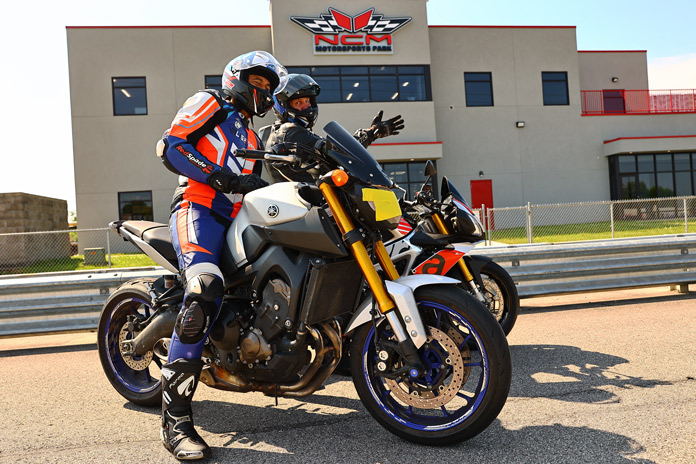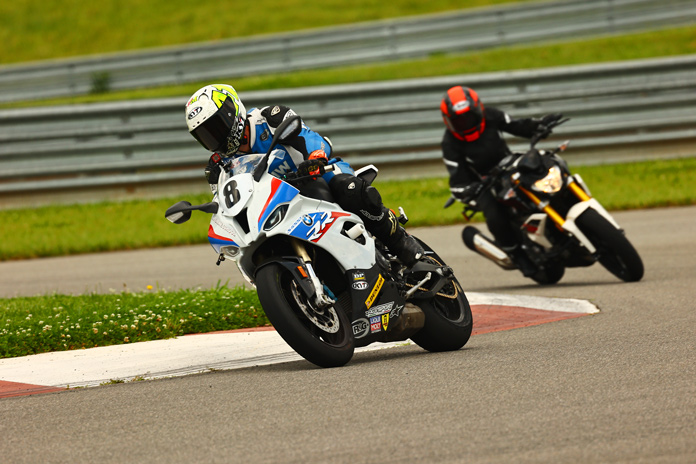
Like any hobby, sport, or activity, riding a motorcycle gets better as the rider gets better. While nothing quite compares to the initial thrills of early riding days, improving riding skills opens doors to new opportunities, builds confidence, and makes riding safer by reducing panic when unfamiliar situations arise.

For a while, I’ve been a good enough rider for the type of riding that I do with my family and friends, which is usually relaxed day trips in low-traffic areas. But since I’ve started working as associate editor at Rider, I’ve ridden a variety of bikes in diverse locations alongside very experienced riders, and it’s led me to believe that “good enough” isn’t quite, at least not for me anymore. I want to be a better rider.
My journey to improve my riding starts with the California Superbike School’s Level I class, which I attended at the NCM Motorsports Park in Bowling Green, Kentucky. Before attending the class and with the help of Cobie Fair of CSS, I graded my current riding on a list of skills using a scale of 1-5, with 5 being the most confident. When I revisited my list after the class, I saw definite improvement almost across the board. As I continue to practice what I learned in the class, I’ll return to this brief questionnaire to measure my progress before jumping into Level II.

California Superbike School: First School of Its Kind
California Superbike School was created by Keith Code in 1980 as the first of its kind track school, and it was based on the techniques and concepts that Code used to coach professional racers. Code has a long list of champions that he’s trained, and although his son, Dylan, runs the day-to-day aspects of CSS now, Keith was present when I attended the class, chatting with students and overseeing the program.

The school is divided into four levels. Those new to CSS start at Level I, regardless of experience or skill set. Levels II and III build on the techniques taught in Level I, while Level IV is a more tailored class that coaches individual students based on their unique needs. Each level can be completed in a day, and two-day camps are available.
Pricing is the same for each level, and you can choose to rent one of CSS’s track bikes, or you can save a couple hundred dollars by bringing your own bike. One-day classes are $845 to rent a bike and $645 if you bring your own. That’s a significant investment, but the class was well worth the price for me. If I’m willing to invest in gear to protect myself while riding, investing in myself to become a better and safer rider is a no-brainer.

California Superbike School: Gotta Start Somewhere
Before the class, I used my questionnaire to grade myself after a ride close to home. Skills included setting the correct entry speed for a corner, quickly steering the bike to avoid unexpected obstacles, steady throttle use throughout the corner, choosing a good line through a decreasing radius corner, and others. Knowing I didn’t quite panic in these situations as I did in my early riding days, I felt like I was at least above a 1 rating on most of these skills, but not much beyond that, so I gave a grade of 2. By the end of the class, I confidently bumped my score up to a 2.5 or 3 on many skills on the list, and I expect those levels to continue to rise.

Upon arriving bright and early on the day of the class, I signed up at the registration table in the paddock, where coaches were greeting students and snacks, coffee, and water were available. The BMW S 1000 RR bikes rented by the school for the class were lined up outside the paddock. Knowing I’d be more comfortable on a smaller bike, I had called ahead to reserve a BMW G 310 R for myself.
Related: 2023 BMW S 1000 RR and M 1000 R | First Ride Review
When it was time to get started, we headed into the classroom for a safety presentation and an explanation about how the day would go. The coaches and instructors introduced themselves, and they explained that we would be divided into three levels for the rest of the day.

GEAR UP
- Helmet: Arai Regent-X
- Jacket: Rev’It Xena 4 Women’s
- Airbag Vest: Alpinestars Tech-Air 5
- Gloves: Rev’It Xena 4 Women’s
- Pants: Rev’It Xena 4 Women’s
- Boots: Alpinestars SMX-6 V2
Throughout the day, we stayed with our assigned group. Level I had six students including myself, and each level covered five lessons throughout the day. Each lesson started with a few minutes in the classroom, followed by a 20-minute track session to practice the exercise explained in the classroom. Right after the track session, we’d meet with our coaches to talk about the session and our individual progress on that lesson. Each group rotated through these three steps, so while our group was in the classroom, another group was on the track, and the other one was talking with their coaches. This system kept everything running smoothly, and it kept the track and other areas from becoming too crowded.

California Superbike School: Diving In
Our first lesson was about throttle control. To start, Dylan Code, the Level I instructor that day, asked our class a few questions to gauge our understanding of throttle control and address any misconceptions. He used a white board to write out and draw concepts as he explained, and he also used photos and videos of both professional racers and CSS coaches that demonstrated correct throttle control. In each lesson, Dylan broke down the basic science behind the technique in a way that was simple enough to understand and paired that knowledge with real-world examples.

As we lined our bikes up to begin our first track session, our on-track coaches introduced themselves. My coach was Lyle, and since we had a smaller group, I was his only Level I student. Even with larger class sizes, each coach will only have 2-3 students per group, which is also why it’s important to register early, as space is limited. Registering a few months in advance is the best way to ensure you’ll get a spot.

Lyle explained that he’d watch me while trackside to observe how I was doing on the track with the throttle control exercise. Then he’d catch up to me and follow me to observe my progress. After following me for a few turns, he’d ride in front of me and use hand signals to communicate what I should be doing with the throttle.

When I started following Lyle’s hand signals as a guide to using the throttle, the classroom lesson began clicking into place, and I began to understand not just the concept of throttle control but also the feeling of correct throttle control. At each corner, my throttle usage smoothed out, and I was better able to judge a good entry speed that wouldn’t require me to make panicked adjustments in the middle of the corners. Before long, we were heading off the track and toward our coaching session.

I met Lyle in the paddock at a table with a map of the track. Lyle made it clear that his job was to make me a better rider and asked how I felt and what I wanted to focus on. He used a dry-erase marker to mark turns where I was doing well and turns that needed improvement. He told me that in our next session, I should focus on smoothing out two particular turns and gave me advice on how to do that. After grabbing some snacks and water in the paddock, it was back to the classroom for the second lesson.

California Superbike School: Step By Step
The lessons continued in a similar way, each one adding concepts and exercises and building on the lessons before. We were told to use no brakes at first and reintroduce brakes in a later session, again slowly adding in extra things without overwhelming students with too much to remember at once.

Once we got into the second half of the day, I told Lyle I was having a hard time choosing the best line at each corner, so although we continued working on the lessons from the classroom, we also worked on choosing lines. He marked a couple of turns where he noticed I would turn in too late or too early, and then on the track, he signaled by pointing to the ground where I should begin the turns and where I should apex. Having this visual cue was a great help, and it felt fantastic to see my lines improving after each session.
Five sessions after the start of the day, it was 5 p.m. and time to get off the track. We were each given a folder with brief explanations of our levels’ lessons, a completion certificate, and more information about the school.

My day at California Superbike School was everything I wanted. The step-by-step system of lessons gave me the tools to continue improving without feeling overwhelmed, and I ended the day tired but excited by my progress. The coaches told me that I’d learn more about visuals and body positioning in Level II, and I’d get the chance to try out some of their specialized training bikes.

This step in my journey to becoming a better rider covered more distance than most. Now it’s time to put in the work and practice what I’ve learned – not a bad way to spend my summer evenings.
Learn more about California Superbike School, view the schedule, and register for a class at the CSS website.
The post California Superbike School Review – Level I appeared first on Rider Magazine.
Source: RiderMagazine.com



































